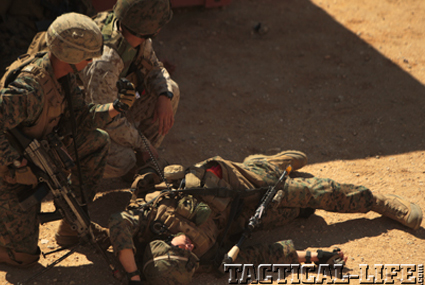By 2007, traveling in Iraq and Afghanistan, especially on foot, had become a nightmare. It wasn’t the physical load of the weapons, ammunition or equipment that made travel especially difficult, but the mental stress of expecting an explosion with every step. Placed strategically along the patrol routes of Coalition Forces, insurgents had found ways of modifying their improvised explosive devices (IEDs) to detonate under the weight or pressure of a victim’s footstep or vehicle’s tire. Referred to as pressure plates, these devices are victim-initiated, meaning they require no human spotters or command detonation, are hard to avoid and near impossible to detect without specialized tools or lengthy searches. Each blast meant a soldier would suffer massive lower-body injuries—if they survived. Medics charged with treating the wounded were especially affected by the new tactic. In addition to damaging flesh and bone, the blasts were also destroying the individual first-aid kits (IFAKs) soldiers carried in their cargo pockets. Intended to stop bleeding, open airways and aid other lifesaving efforts while under fire, the kits were critical to the survival of the wounded, but blast pressure and fragmentation from the pressure pads was shredding their contents and rendering them useless.
SEAL Solution
This was the reality confronted by Special Operations Chief Michael “Rex” Tathem, a U.S. Navy SEAL and qualified medic, when his team deployed to the Middle East in support of Operation Iraqi Freedom and later to Afghanistan in support of Operation Enduring Freedom. Encouraging his subordinates to find a solution, Tathem was soon presented with a simple but innovative idea. Drawing on experience as a SEAL and former Navy corpsman, another medic was already concerned with a pattern of people forgetting to bring their IFAKs on missions and had been considering better ways to carry it. Asking what was never forgotten in the rear, it dawned on the medic that no matter the circumstances, every solider, sailor, Marine and SEAL donned their armor before going out on missions. Stuffing a pack into the interior pocket of a ballistic plate carrier would prevent trauma kits from being left behind, and placing it behind the armor might alleviate much of the damage expected if it was instead carried in an unprotected cargo pocket.
Tathem applied his limited resources in the field to adapting the blowout kits for wear behind armor plates, removing the contents of existing nylon IFAK pouches issued to every sailor and placing them in narrow plastic sleeves that the plate carriers could accommodate. He never found the perfect container, but even the homemade kits seemed more functional and protected than their counterparts. The idea was a hit with his team and quickly spread to others in theater, becoming a preferred method of carry. By this point, most of the teams realized the IFAK in its standard form was a problem in an environment rife with explosions and gunfire. The issue hit home with the death of Virginia-based SEAL Caleb Nelson in October 2011. While conducting a mounted patrol in Zabul Province, a territory on the Afghanistan-Pakistan border known as a crossing point for foreign fighters aligned with the Taliban, Nelson’s vehicle struck an IED concealed along the roadside. The blast caused extensive injuries to the lower half of his body and rendered his IFAK useless. Though he may have succumbed to his injuries even with a kit, the lack of one available on his person was distressing and increased the demand for an alternative.
Advertisement — Continue Reading Below
Chief Tathem died later the same month, and though he never saw a newly designed IFAK materialize, other members of the team were passionate enough about the change to ensure it was made available. Back in the States, between deployments, the medic who first suggested placing the kit in a carrier approached Phokus Research Group, a SEAL-led research and development company that takes quality ideas from SEAL team members in the field and makes them a commercially available reality. What Phokus ultimately produced is the latest innovation in battlefield medicine. Billed the Sons Trauma Kit, the SEAL vision is realized with a kit that provides the same materials of other trauma or blowout packs, but in a plastic container that fits perfectly behind the armor of every standard-issue U.S. military plate carrier.
SONS First-Aid
Sons kits are vacuum-sealed with a one-way purge valve to exhaust air and allow the flattest possible profile. This design enables users to carry a blowout kit without the use of additional bulky pouches that take up real estate in pockets, on the outside of carriers or on belts, where they are more likely to be rendered useless by blast and fragmentation damage. The kits are the same surface size as government-issued SM/MD Level III ballistic plates and are approximately a half-inch thick at their widest point. All kits are secured with glue for a lasting seal and packed in a way that prioritizes items based on the severity of the injury they would be used to treat per Tactical Combat Casualty Care (TCCC) guidelines. Several models are available, but each carries a standard complement of self-aid medical supplies.
Sons Trauma Kits don’t revolutionize the contents of the standard-issue blowout kit, but they improve on the usual method of carry and may prove to achieve their creators’ goal of saving more lives by protecting the contents from damage. Their design and intended placement is based on hard operational lessons, learned only through the loss of the life, and was developed by professional warriors whose own lives depend on the equipment to get them out of conflict alive. Chief Tathem didn’t survive to see the kit being issued to his team, but it’s now carried in every SEAL’s plate carrier, protected and ready to help save them in the event an operation goes south. Expect wider distribution as other military units and law enforcement agencies catch on. For more information, visit phokusresearch.com or call 858-413-7746.
Advertisement — Continue Reading Below









































